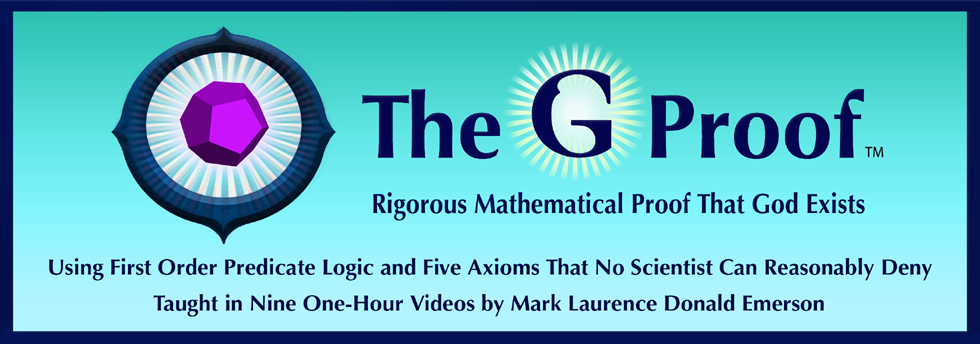Video 7: Last 2 Axioms, Consistency and Informal Proof God Exists
Short Synopsis of Video 7
The last two of our five axioms — A4 and A5 —" are presented and justified. Teaches how a set of axioms can be shown to be consistent by finding a simple interpretation (aka model) that makes all the axioms true. This is done, which makes Axioms A1-A5 consistent. Presents an informal proof that God exists, using diagrams (this is not a formal proof, and it doesn't count).

|
Long Synopsis of Video 7
Video Seven is the second of three Videos (Six, Seven and Eight) that present our proof that God exists. Videos Six and Seven set the stage, and then Video Eight presents the proof.
Video Seven presents the last two of our five axioms and justifies them. Axiom A4, the Complete Causation Axiom, states that anything that causes something must completely cause that thing, including all its parts, which is justified by the No Donut Holes Principle. Axiom A5, the Causal Extension Axiom, states that there exists a phenomenon whose parts are all phenomena that cause anything. This is justified by an analogy to astronomy, in which all the stars in the universe (excluding planets, dust, comets, etc.) unquestionably exist collectively as a phenomenon ("all stars").
A closer examination is then made of Axiom A4, and a potential objection to it based on self-caused phenomena, but the objection is resolved by another readily justified principle not needed as an axiom.
Discusses, conceptually, interpretations of a mathematical theory. Distinguishes three kinds of statements: ordinary statements (whose truth depends on the interpretation), tautologies (which are true regardless of interpretation) and contradictions (which are false regardless of interpretation). Teaches that consistency of a set of axioms is defined as the impossibility to prove a contradiction from them. Teaches that First Order Predicate Logic has the property of Soundness, and that, because of Soundness, finding a simple interpretation (aka model) that satisfies a set of axioms shows they are consistent. A Tiny Interpretation is used to show Axioms A1-A5 are consistent.
An informal proof that God exists is then presented, as follows. We start by asking a Cosmic Question ("Why is there causation?"), to which Axioms A5 and A1 give us an answer we call g, which is our candidate for God. We then use Axiom A4 to show g is self-caused, Axioms A4 and A2 to show g is omnipotent (causes everything), and Axiom A3 to show g is unique. Diagrams show that g "curves back" to cause everything else. The purpose of the informal proof is to see the "big picture," but it does not actually "count" — what counts is the formal, rigorous proof presented in Video Eight.
Errata for Video 7
24:40 — Mr. Emerson says "P or Q" when he should have said "P or not P."
42:00 — Mr. Emerson says "which means that it proves Q and not Q," when he should have said "which means that it makes Q and not Q true."
42:10 — Mr. Emerson says "no interpretation can prove a contradiction," when he should have said "no interpretation can make a contradiction true."
